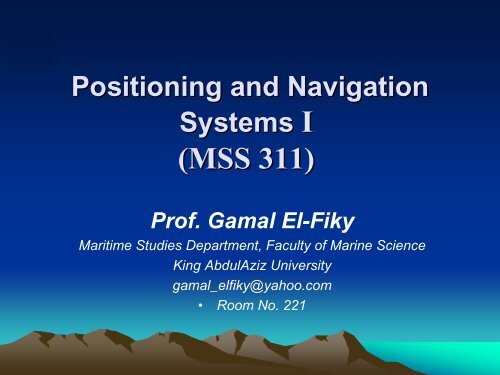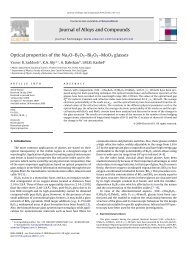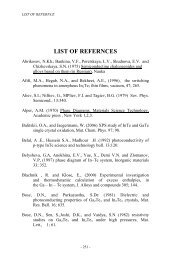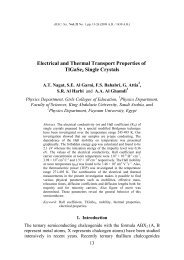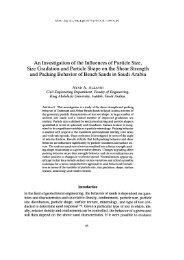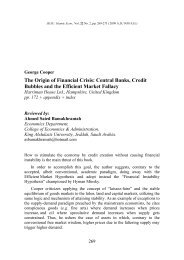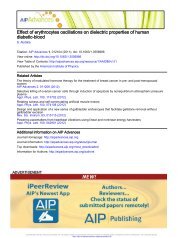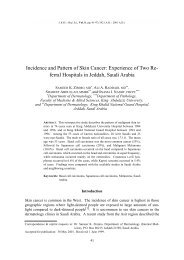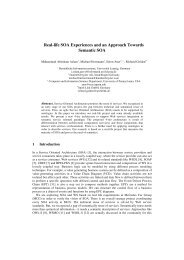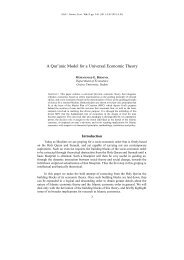The Compass Errors
The Compass Errors
The Compass Errors
Create successful ePaper yourself
Turn your PDF publications into a flip-book with our unique Google optimized e-Paper software.
Positioning and Navigation<br />
Systems I<br />
(MSS 311)<br />
Prof. Gamal El-Fiky<br />
Maritime Studies Department, Faculty of Marine Science<br />
King AbdulAziz University<br />
gamal_elfiky@yahoo.com<br />
•<br />
Room No. 221
Chapter 3<br />
<strong>The</strong> Marine Magnetic<br />
<strong>Compass</strong>
•<br />
•<br />
Magnetic <strong>Compass</strong><br />
<strong>The</strong> magnetic compass still retains its<br />
importance despite the invention of the<br />
gyro-compass. While the latter is an<br />
extremely accurate instrument, it is<br />
relatively expensive, highly complex,<br />
dependent on an electrical power supply,<br />
and subject to mechanical damage.<br />
<strong>The</strong> magnetic compass is less expensive,<br />
entirely self-contained, fairly simple, and<br />
not easily damaged.
•<br />
•<br />
•<br />
•<br />
What We’ll We ll Cover<br />
<strong>Compass</strong> design<br />
Principles of operation<br />
Deviation & swinging ship<br />
<strong>Compass</strong> calculations
Parts of a <strong>Compass</strong><br />
Constructed of nonmagnetic<br />
materials.
Parts of a <strong>Compass</strong><br />
Indexed card to read<br />
direction.
Parts of a <strong>Compass</strong><br />
Lubber line pins to<br />
align compass with<br />
boat.
Parts of a <strong>Compass</strong><br />
Gimbal system to keep<br />
card level when ship<br />
heels and pitches.
Parts of a <strong>Compass</strong><br />
Spherical bowl with<br />
expansion diaphragm.
Parts of a <strong>Compass</strong><br />
Fluid filled damping<br />
system to impede<br />
rapid card movement.
Parts of a <strong>Compass</strong><br />
Compensation system<br />
to reduce deviation<br />
error.
Steering <strong>Compass</strong> Styles<br />
Top Reading Card<br />
Usually used in binnacle<br />
steering stations.<br />
Front Reading Card<br />
Used when compass<br />
mounted on bulkhead.
Hand Bearing <strong>Compass</strong> Styles<br />
Front/Top Reading
•<br />
•<br />
•<br />
•<br />
•<br />
<strong>Compass</strong> Card<br />
Graduated in degrees from 000 to<br />
359.<br />
Graduated in 1, 2, 5 degree<br />
increments.<br />
Numbers spaced every 10-30<br />
degrees.<br />
Usually show cardinal points: N, S,<br />
E & W.<br />
May show intercardinal points: NE,<br />
SE, SW & NW.
<strong>Compass</strong> <strong>Errors</strong><br />
Deviation and Variation<br />
<strong>The</strong> unattractive Truth<br />
…<br />
<strong>Compass</strong>es don’t don<br />
point to True North!
•<br />
Variation: (Magnetic rose)<br />
<strong>Compass</strong> <strong>Errors</strong><br />
It is the difference at any location between the directions<br />
of the magnetic and true meridians.<br />
– Geographic (true) vs. magnetic north.<br />
– Common to all parts of the globe.<br />
– Identified on every chart’s compass rose's.<br />
•<br />
Deviation: (From deviation tables)<br />
It is the divergence between the N-S axis of<br />
the compass card and the magnetic meridian.<br />
– Caused by shipboard magnetic influences.<br />
– Exists on all vessels; different for each vessel.<br />
– It varies widely.<br />
<strong>The</strong> <strong>Compass</strong> <strong>Errors</strong>: <strong>The</strong> algebraic sum of variation<br />
and deviation<br />
C.N<br />
M.N<br />
Dev. Var.<br />
T.N
•<br />
Example:<br />
If the variation was 05° 55‘ W (in 1979),<br />
decreasing about 4‘ annually, calculate variation<br />
in year 2008.<br />
Solution:<br />
2008<br />
1979<br />
0029 years × 4‘=116‘= 01° 56‘<br />
<strong>The</strong>n: Var. (1979)= 05° 55‘ W<br />
-01° 56‘<br />
03°59‘ W
•<br />
Earth -<br />
Variation:<br />
A Magnet<br />
Locating exact source of<br />
magnetism difficult.<br />
– Alignment of magnetism<br />
changes.<br />
– Strength of pull varies<br />
over earth.
•<br />
•<br />
•<br />
•<br />
•<br />
•<br />
•<br />
•<br />
•<br />
•<br />
•<br />
Deviation Table (1)<br />
<strong>Compass</strong> Course Deviation <strong>Compass</strong> Course Deviation<br />
000°<br />
010°<br />
020°<br />
030°<br />
040°<br />
050°<br />
060°<br />
070°<br />
080°<br />
090°<br />
C 4.0°<br />
C 3.0°<br />
C 2.0°<br />
C 0.4°<br />
C 1.2°<br />
C 2.2°<br />
C 3.0°<br />
C 4.2°<br />
C 5.4°<br />
C 4.3°<br />
E 180°<br />
E 190°<br />
E 200°<br />
E 210°<br />
W 220°<br />
W 230°<br />
W 240°<br />
W 250°<br />
W 260°<br />
W 270°<br />
C 3.1°<br />
C 2.2°<br />
C 0.6°<br />
C 2.0°<br />
C 3.2°<br />
C 4.4°<br />
C 5.6°<br />
C 4.0°<br />
C 3.4°<br />
E<br />
E<br />
E<br />
W<br />
W<br />
W<br />
W<br />
W<br />
W<br />
C 2.1° W
•<br />
Example (1)<br />
Find the deviation of course 217°.<br />
Solution:<br />
<strong>Compass</strong> C. Deviation<br />
210°<br />
2.0° W<br />
220°<br />
3.2° W<br />
10 1.2<br />
03 X<br />
<strong>The</strong>n Deference of Dev.= 3×1.2/(10)=0.36°<br />
So, Deviation of Course 217° = 3.2-0.36 = 2.84°W
•<br />
Examples (2 & 3)<br />
If the variation is 3°E, and the deviation is 2°E. Calculate<br />
the compass error?<br />
Solution:<br />
Variation = 3°E<br />
Deviation = 2°E<br />
<strong>Compass</strong> error = ΣVariation + Deviation = 3 +2 = 5°E<br />
•<br />
If the variation is 4°W, and the deviation<br />
is 2°E. Calculate the compass error?<br />
Solution:<br />
Variation = 4°W<br />
Deviation = 2°E<br />
<strong>Compass</strong> error = -4 + 2 = 2°W<br />
T.N<br />
Var.<br />
M.N<br />
Dev.<br />
C.N
•<br />
Examples (4 & 5)<br />
If the C Bearing = 052°C, Var. 4°W and the Dev. = 1°E. Calculate<br />
True Bearing.<br />
Solution:<br />
Variation = 4°W C. Bearing = 052°C<br />
Deviation = 1°E C. error = 3°W<br />
<strong>Compass</strong> error = 3°W T. Brg. =049°<br />
•<br />
If the compass Bearing is 028°C, and the true Bearing is 025°T,<br />
Find the <strong>Compass</strong> error.<br />
Solution:<br />
T. Brg. = 025°T<br />
C. Brg. = 028°C<br />
<strong>Compass</strong> error = 003°W<br />
Note: (If C less than T the error is East and if C<br />
greater than T is West.
•<br />
•<br />
•<br />
Deviation:<br />
Ship-Specific Ship Specific Error<br />
Due to on-board magnetic influences:<br />
–<br />
–<br />
–<br />
Magnetic items<br />
Items to which magnets are attracted.<br />
Wires carrying DC electrical current.<br />
Reduce effects as much as possible:<br />
–<br />
–<br />
Keep compass away from influences<br />
Twist nearby DC wire pairs.<br />
Usually can’t eliminate them all.
Additive Effect<br />
of <strong>Compass</strong> <strong>Errors</strong><br />
Error due to<br />
015° W<br />
variation<br />
Additional<br />
error due to<br />
005° W<br />
deviation<br />
Desired True<br />
heading<br />
<strong>Compass</strong><br />
heading must be<br />
adjusted 020° to<br />
compensate.
•<br />
•<br />
Measuring Deviation<br />
Yourself<br />
By using Deviation table or Curve we can obtain<br />
the deviation value of a specific <strong>Compass</strong> course.<br />
First you have to know how to do some compass<br />
calculations.
•<br />
•<br />
•<br />
•<br />
Compensation<br />
Deviation often greater than 10º.<br />
Special magnets (compensators) installed<br />
in compasses to reduce error.<br />
Most compasses come with instructions.<br />
Can still have significant deviation<br />
error after compensation.
+W<br />
T<br />
V<br />
M<br />
D<br />
C<br />
Computing<br />
<strong>Compass</strong> Corrections<br />
True Heading<br />
Variation on Chart<br />
Magnetic Heading<br />
Deviation<br />
<strong>Compass</strong> Course<br />
000<br />
015 W<br />
015<br />
005 W<br />
020
•<br />
•<br />
Isogonic<br />
Chart<br />
Illustrates<br />
magnetic<br />
variation<br />
(1995)<br />
World-Wide World Wide Variation
•<br />
•<br />
•<br />
•<br />
•<br />
“Swinging Swinging Ship” Ship<br />
Process of measuring residual deviation<br />
error after compensation.<br />
Usually determined in 15º - 30º heading<br />
increments.<br />
Recorded in form of deviation table.<br />
<strong>Compass</strong> adjuster can provide service.<br />
Or, you can do it yourself ...
•<br />
•<br />
•<br />
Back to<br />
Measuring Deviation<br />
For each 15º<br />
–<br />
–<br />
–<br />
-<br />
30º, you need to:<br />
Know exactly what direction<br />
(magnetic) your boat is pointed.<br />
Compare with compass reading.<br />
Compute deviation.<br />
Key to puzzle is knowing exactly<br />
what direction you’re headed.<br />
<strong>The</strong>re are several ways ...
•<br />
•<br />
•<br />
•<br />
Example Way to<br />
Know Your Heading<br />
In calm water with minimal current:<br />
Remaining in vicinity of ATON …<br />
Record both<br />
compass heading<br />
& relative bearing<br />
every 15° -- 30°.<br />
Compute deviation<br />
for each heading.<br />
Means to Take<br />
Relative<br />
Bearing<br />
Close to<br />
Reliable<br />
ATON<br />
Known<br />
Direction<br />
Charted<br />
Object<br />
6+ Miles<br />
Distant
•<br />
•<br />
•<br />
•<br />
Measuring Relative Bearings<br />
Mounted parallel to vessel’s<br />
keel with all-around view.<br />
0º<br />
aligned with keel.<br />
Align targets in sights.<br />
Read relative bearing<br />
on scale.
Electronic Steering <strong>Compass</strong>es<br />
Feature automated<br />
deviation elimination!
•<br />
•<br />
•<br />
Local Magnetic Disturbances<br />
<strong>Compass</strong> still<br />
seems wrong?<br />
In some locations there are<br />
local magnetic disturbances<br />
that can affect you compass.<br />
Often noted on charts.
All this sound complex?<br />
Perhaps, but the best solution is:<br />
Practice ...<br />
Practice ...<br />
Practice!
Shipboard <strong>Compass</strong>es<br />
Precession axis<br />
Spin axis<br />
Torque axis<br />
–<strong>The</strong> gyrocompass has three axes: the spin axis, torque axis,<br />
and precession axis.<br />
–As centrifugal force of the earth’s rotation (tangential<br />
velocity), acts upon the gyro, the torque and precession axis<br />
will react, and keep the spin axis oriented to a terrestrial<br />
meridian.
•<br />
<strong>The</strong> Gyro-compass (cont’d)<br />
–<br />
–<br />
<strong>The</strong> gyrocompass has several advantages over the<br />
magnetic compass:<br />
•<br />
•<br />
•<br />
•<br />
It seeks true or geographic meridian instead of magnetic<br />
meridian.<br />
It can be used near the earth’s magnetic poles, where the<br />
magnetic compass is useless.<br />
It is not affected by surrounding material.<br />
Its signal can be fed into inertial navigation systems, automatic<br />
steering systems, and fire control systems.<br />
Being a complicated electronic instrument, the<br />
gyrocompass has some disadvantages<br />
•<br />
•<br />
Shipboard <strong>Compass</strong>es<br />
It requires a constant source of electrical power and is sensitive<br />
to power fluctuations.<br />
It requires periodic maintenance by qualified technicians.
•<br />
Shipboard <strong>Compass</strong>es<br />
Methods of determining gyrocompass error<br />
–<br />
–<br />
–<br />
Although the gyrocompass is a very accurate<br />
instrument and normally has a very small error<br />
associated with its readings (less than .10 to .20 ).<br />
<strong>The</strong> navigator is required to determine gyro error at<br />
least once a day.<br />
Gyrocompass error like magnetic compass error, is<br />
measured in degrees east or west
–<br />
Shipboard <strong>Compass</strong>es<br />
If the gyrocompass bearing is higher than the actual<br />
bearing, the error is west<br />
Gyro<br />
north<br />
True north<br />
090<br />
095 p stg c<br />
– If the gyrocompass bearing is lower than the actual<br />
bearing, the error is east<br />
True north Gyro<br />
north<br />
090<br />
085 p stg c<br />
Tank<br />
Tank
End Chapter 3<br />
كﻮﻣﺮﻴﻟا


